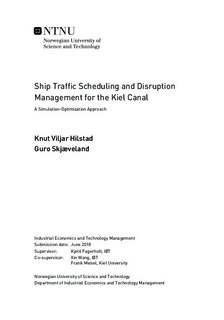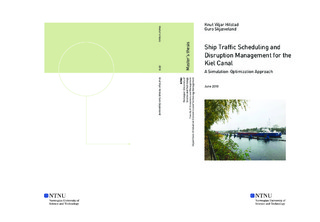| dc.description.abstract | The Kiel Canal is a nearly 100 km long artificial waterway that connects the North Sea and the Baltic Sea through the north of Germany. The canal alternates between wide and narrow segments, and on the narrow segments the passing of large ships is considered unsafe. Therefore, a traffic management system is needed. The purpose of the system is to decide which ships that have to wait on the wider segments in order to ensure safe passage of all ships. The decisions affect the transit times of ships, and thus, have a major impact on the attractiveness for shipping companies to send their vessels through the canal.
In this thesis, the Kiel Canal Ship Traffic Optimization Problem (KCSTOP) is defined, and an optimization model is developed for the problem. The model captures the relevant traffic rules and safety requirements, with the goal of generating conflict-free schedules while minimizing total travelling time for all ships. The decisions to be made are which sequence the ships sail in, at which velocity each ship traverses at, and where and for how long each ship waits in order to mitigate potential conflicts.
The KCSTOP is modelled as a static and deterministic problem. However, the daily scheduling task is in reality exposed to both dynamism and stochasticity. Ships arrive at the canal continually, and events may occur that disrupts the schedule. Thus, the Dynamic Kiel Canal Ship Traffic Optimization Problem under Uncertainty (DKCSTOP) is established. The complexity of the problem makes it hard to model mathematically, and therefore a simulation-optimization framework is developed. The framework solves the problem by generating a composite schedule which is composed of consecutive solutions to constrained versions of the KCSTOP, found by using a rolling horizon scheduling procedure.
The traffic flow and possible disruptive events are simulated. The two disruptive events incorporated are ships arriving at the canal later than planned (delay), and ships sailing at a lower velocity than planned (slowness). In order to mitigate the impact of disruptions, appropriate strategies are implemented. Real-time replanning is one strategy, while another is to postpone waiting of ships. The latter is implemented by altering the mathematical formulation of the KCSTOP, and is referred to as the weighted approach.
How the different disruption management strategies perform in a dynamic and stochastic planning environment is tested in the developed simulation-optimization framework. The DKCSTOP is solved in the framework over 63 different scenarios. Results show that real-time replanning manages to nullify disruptions caused by delay. In the scenarios where slowness occurs, the solution is at most compromised by 3.8% compared to the disruption-free scenarios. When using the weighted approach, the solution quality is on average improved in all scenarios. In scenarios where both disruptive events occur frequently, the approach reduces average traversing time with nearly three minutes. This is roughly equivalent to 300 000 dollars saved for shipping companies yearly.
In addition to evaluating the performance of disruption management in the developed framework, several other features are examined: The limits on waiting times for ships, and the requirement that ship captains report the vessel s position prior arrival, to name a few. | |

